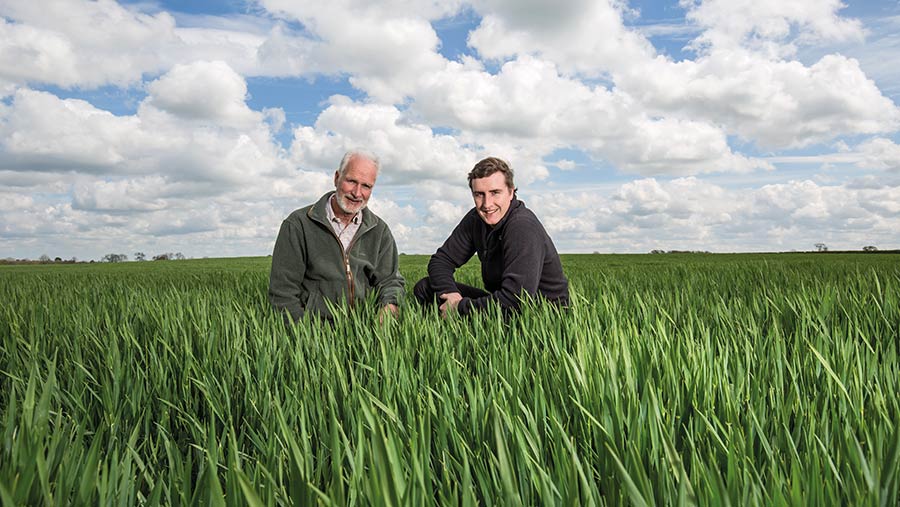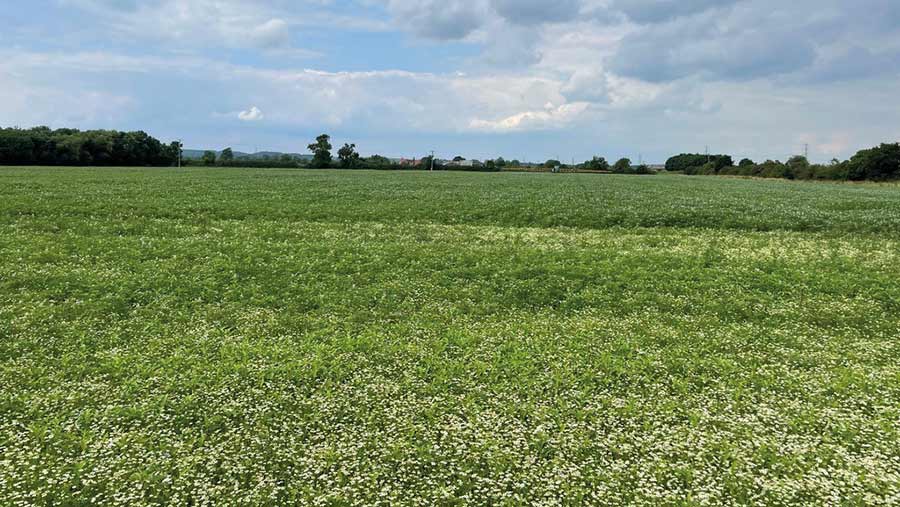How one Notts farm’s cropping benefits from a poultry focus
 © Yuliya/Adobe Stock
© Yuliya/Adobe Stock Growing five different crops to save money on expensive bought-in feed for 72,000 layers is helping one farming family reduce its carbon footprint, improve soil health and tackle a blackgrass problem.
In addition, integrating the layers with arable cropping at Sherwood Farms is helping the Parker family manage risk, resulting in a more sustainable business.
See also: Analysis: Could lupins solve the break crop challenge?
Father and son James and Michael Parker, along with Michael’s uncle Andrew run a 72,000-bird layer unit just outside Hickling, a village eight miles north-west of Melton Mowbray. They sell eggs to the local wholesale market, restaurants and shops.

Father and son James and Michael Parker © AHDB
They have a mix of free range and enriched colonies on the farm, which has had layers since the 1960s.
However, feed costs have been rising, not helped by soya bean meal reaching nearly £400/t last May, although the price has since eased back a bit.
Having a mill and mix plant, the family was already growing cereals for the layers and soaring soya prices prompted the decision to grow their own protein too.
It wasn’t just economics, they also want to be more sustainable and have less reliance on imported soya. Soya bean meal accounted for about 18% of the ration.
And last season saw lupins in the rotation for the first time at Sherwood Farms, selected for their high protein content of 33-35%.
Michael explains that wheat only has 11.5% protein compared with high-pro soya at 46%. Beans are also a valuable protein at 22.5%, but they needed something higher.
Furthermore, lupins don’t need any processing like soya does, making them more practical than growing their own soya crop.
Crops grown
Last season, the Parkers grew wheat, winter triticale, spring barley, beans and lupins, with two-thirds of the ration now grown on the farm. This means the arable side is benefiting from a much more varied rotation.
The first crop of lupins came in at 28.5% protein, and while it was a little lower than target, it still replaced 12.5% of the soya in the 3,000t of feed used in a year.
This season, they are planning to double the area of lupins to increase the inclusion level, although James points out that there is a maximum limit due to its alkaloid content.
Lupin performance
The family grew Dieta, which is a white type lupin and it yielded an average 2.8t/ha, with one field over 3t/ha. This was a bit lower than anticipated, but Michael pointed out that they were direct drilled on 20 April and didn’t germinate for a while, as conditions were dry.
He says they should have received a pre-emergence herbicide, but was too dry. So they had to rely on the more expensive post-emergence options of Lentagran (pyridate) for broad-leaved weeds and Centium (clomazone) for grassweeds.
No fungicides, growth regulators or slug pellets were needed, so input costs were only £100/ha.
Farm facts
- Area: 630ha
- Cropping: Winter wheat, spring barley, winter and spring beans, winter triticale, spring linseed and lupins
- Soil: Ranges from heavy clay to clay and sandy loam
- AHDB Monitor Farm since May 2019
Home-grown cereals
For wheat, the family grew Firefly, with the surplus sold for a small group 3 biscuit-making premium. Due to its reduced yellow rust rating, Extase is the variety for this season, with 253ha in the ground.
Winter triticale is the second cereal, as it performs more consistently than a second wheat on their soils. James points out that it has a slightly better amino acid profile than wheat, so will benefit the layers.
And the extra straw yield brings a bonus, being sold to neighbouring dairy farms, producing milk for the local Stilton creameries.
Spring barley (Planet plus a bit of Laureate) is also grown, with the remainder sold for malting. This year it yielded well at 8t/ha.
For winter beans, they grew the variety Target, which yielded well with an average of over 6t/ha and the spring beans were just a touch behind at 5.9t/ha.
“Spring beans was the crop of the year,” says James.
They invested in the crop, spending £20/ha on trace elements, £100/ha on herbicides and £32/ha for disease control.
But Michael believes the good yields were down to being sown behind a subsoiler, which loosened the soil and let surplus moisture soak away.
“The other crops suffered from the surplus moisture.”
Rotation benefits

One key benefit of growing lupins and beans is that they fix nitrogen in the soil. In fact, lupins are more effective than beans, at 230-240kg/ha compared with 180kg/ha.
The Parkers hope to see the benefits in wheat yields after. “It’s a nice bonus in a year of high fertiliser prices,” says Michael.
The lupins were harvested on 7 October and they noted much fewer harvest losses than typically seen in beans, as pods held on to the seed. But the downside was that they took a lot of drying as they were protected by the green pods. Consequently, they were cut at 22% moisture and dried.
Last season, they had 83ha beans and 23.5ha of lupins. This is higher than normal, because of last year’s wet autumn leading to spring beans being grown instead of the winter wheat that wasn’t drilled. Normally, they would have 40-50ha of beans.
Michael is aiming for a rotation of winter wheat, winter beans, winter wheat, spring barley then either spring linseed or lupins. This diverse rotation with two spring crops is helping the family tackle a blackgrass problem, which is now improving.
In addition, the family abandoned oilseed rape in 2020, which is seen as the weak link in the rotation for the grassweed, as the weed benefited from patchy crops, taking hold in the more open patches.
They grow linseed instead, which leaves the soil more friable and they have also used far fewer slug pellets since dropping the crop.
Fertiliser benefits
The arable side is also benefiting from the layer manure, which is saving on bought-in fertiliser. They are spreading 2,100t of manure each year which equates to 40t of nitrogen based on previous analysis of the manure and Fertiliser Manual figures for availability.
That is quite a saving, especially with ammonium nitrate prices exceeding £600/t.
The manure is used to top dress the second cereal and spring barley when it has emerged. They have a good spreader with twin discs, so it can be spread evenly in spring.
One of the benefits of having a mixed farm and growing their own poultry feed is that the business has a negative carbon footprint with a recent calculation suggesting a whole farm sequestration of 47,488t of carbon dioxide equivalents a year.
They are currently looking into the option of selling the credits to benefit from their carbon credentials.
Compost improves soil health
The Parker family have a composting business, which has been used for the past 17 years to improve soil health on their light land farm.
Seen more as a soil conditioner, compost has been spread in the spring on their lighter, sandier farm near Nottingham, which is mainly sand over gravel. It had low soil indices and organic matter levels and 17 years of use has brought levels up to 6-7% organic matter (loss on ignition).
“It has resulted in soil being more moisture retentive,” says Michael Parker.

